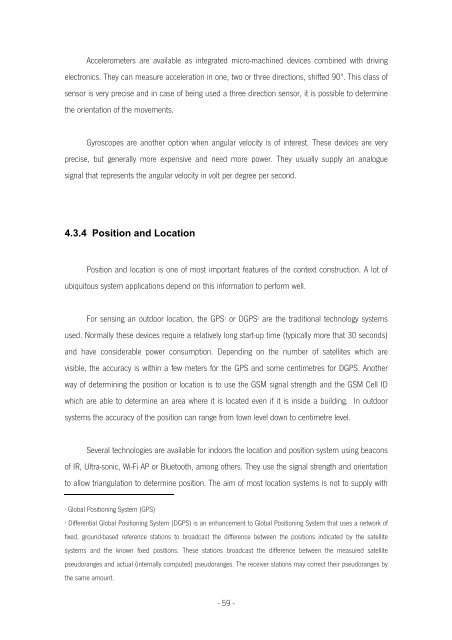Carlos Manuel Rodrigues Machado Autonomic Ubiquitous Computing
Carlos Manuel Rodrigues Machado Autonomic Ubiquitous Computing
Carlos Manuel Rodrigues Machado Autonomic Ubiquitous Computing
Sie wollen auch ein ePaper? Erhöhen Sie die Reichweite Ihrer Titel.
YUMPU macht aus Druck-PDFs automatisch weboptimierte ePaper, die Google liebt.
Accelerometers are available as integrated micro-machined devices combined with driving<br />
electronics. They can measure acceleration in one, two or three directions, shifted 90º. This class of<br />
sensor is very precise and in case of being used a three direction sensor, it is possible to determine<br />
the orientation of the movements.<br />
Gyroscopes are another option when angular velocity is of interest. These devices are very<br />
precise, but generally more expensive and need more power. They usually supply an analogue<br />
signal that represents the angular velocity in volt per degree per second.<br />
4.3.4 Position and Location<br />
Position and location is one of most important features of the context construction. A lot of<br />
ubiquitous system applications depend on this information to perform well.<br />
For sensing an outdoor location, the GPS 1 or DGPS 2 are the traditional technology systems<br />
used. Normally these devices require a relatively long start-up time (typically more that 30 seconds)<br />
and have considerable power consumption. Depending on the number of satellites which are<br />
visible, the accuracy is within a few meters for the GPS and some centimetres for DGPS. Another<br />
way of determining the position or location is to use the GSM signal strength and the GSM Cell ID<br />
which are able to determine an area where it is located even if it is inside a building. In outdoor<br />
systems the accuracy of the position can range from town level down to centimetre level.<br />
Several technologies are available for indoors the location and position system using beacons<br />
of IR, Ultra-sonic, Wi-Fi AP or Bluetooth, among others. They use the signal strength and orientation<br />
to allow triangulation to determine position. The aim of most location systems is not to supply with<br />
1 Global Positioning System (GPS)<br />
2 Differential Global Positioning System (DGPS) is an enhancement to Global Positioning System that uses a network of<br />
fixed, ground-based reference stations to broadcast the difference between the positions indicated by the satellite<br />
systems and the known fixed positions. These stations broadcast the difference between the measured satellite<br />
pseudoranges and actual (internally computed) pseudoranges. The receiver stations may correct their pseudoranges by<br />
the same amount.<br />
- 59 -

















